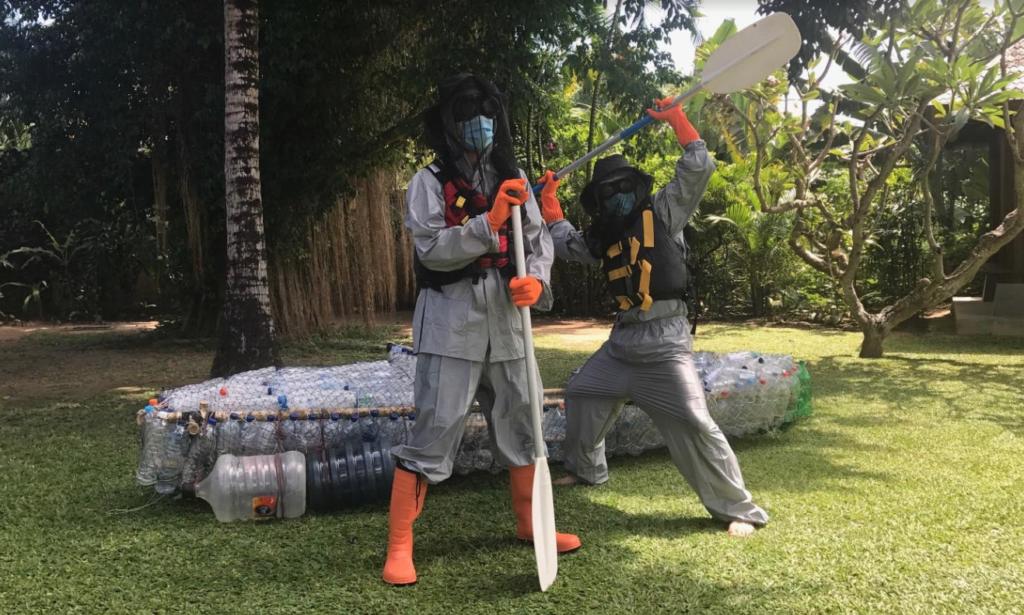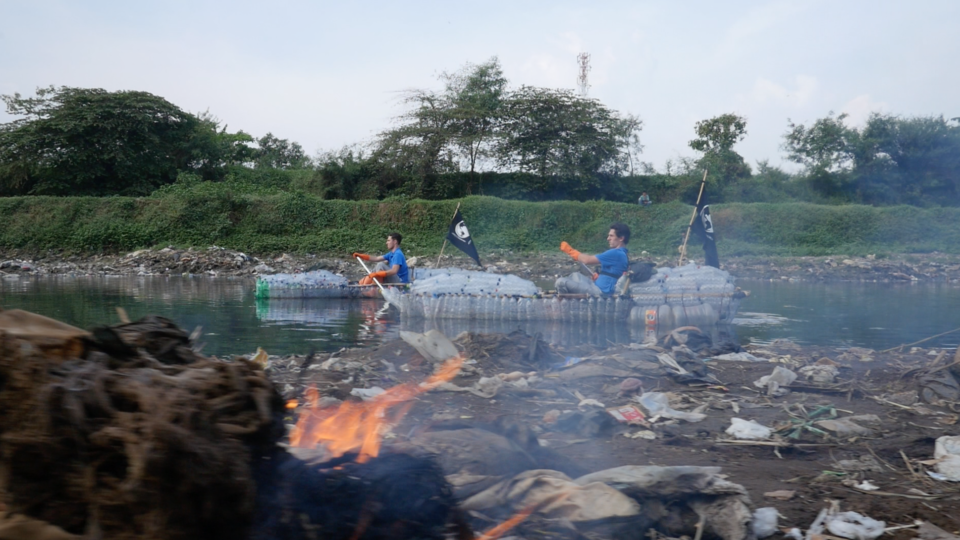A pair of brothers from Bali is paddling down Indonesia’s toxic Citarum River on two kayaks they had built –custom-made from bamboo and discarded plastic bottles — to create a “shocking visual” and “bring awareness about the dangers of plastic pollution.”
Flowing through industrial West Java, the Citarum is said to be the most polluted river in the world. More than 15 million people live on the Citarum and most of them rely on its flow for their water supply.
It’s no news that Indonesia’s oceans are becoming trash graveyards with heaps of rubbish washing back ashore, blemishing the country’s beautiful beaches every year, but what doesn’t get talked about so much is that 80 percent of plastics that wind up in the ocean come from land-based sources, specifically rivers and streams—like the Citarum in Java.
“Plastics is having a major toll here in Indonesia. Being the biggest archipelago in the world, we really wanted to created a shocking visual of all this trash that’s coming in from our rivers into the ocean,” says the older of the two brothers, Gary Bencheghib, in a video promoting the eco-awareness project created through the brothers’ media page, Make a Change.
“We have to start from our rivers. because that’s where we can still capture the waste before it gets out in the open sea.”
That’s why Gary, 22, along with brother Sam, 20, decided to have two kayaks fashioned by bamboo experts, EWABI, each boat with a bamboo frame filled with 300 plastic bottles to keep things afloat. The bottles were collected with the brothers’ local partner, ecoBali, from school groups and waste facilities.
They hope their expedition will demonstrate that trash isn’t just something that should be tossed away, but rather that it’s a “valuable material” that can be “reused for other things.”
The brothers started paddling from Majalaya on August 14, kicking off their expedition in the upper Citarum, then continued last week from Karawang to Pantai Bahagia.
Coconuts Bali caught up with Gary to get a little more information about the expedition.
Where did the idea for this expedition originate from?
When I started Make a Change Bali, I would have never thought that so much of (trash) came from land sources. The realization hit when I sailed down the Mississippi River last summer. We were doing microplastic testings and were so shocked to find so many of them everywhere we would go. Spent two months shooting a film on plastics in river in Indonesia and again, it was everywhere you looked. So really hoping that this Citarum project wakes up the conscience and can provide a shocking visual to mobilize cleanups and action to prevent plastics from entering into our oceans.
Why is the Citarum so bad in particular, of all the rivers in Indonesia?
It’s really the accumulation of toxic waste and household waste, but mainly toxic waste. With Bandung being the industrial capital of Indonesia and especially that of textile, so much of the industries waste is being dumped right into the river without much filtration. We could see all sorts of nasty colors coming out of giant tubes right into the river. You had red, blue, black. At one point, a very smokey grey that smelled like sulfur.
Could you tell us more about some of the safety precautions you’re taking to paddle down this river? What happens if someone falls in?
The Citarum has been ranked for the last five years among the most polluted and dirtiest rivers in the world. An estimated 25,000 cubic meters of household waste and 280 tons of industrial waste is being dumped in the Citarum river every day. We have been using full body suits, but due to the heat, it’s been a constant struggle wearing our gear or not. By the first day, we could hardly breathe with our masks on. So we decided to lighten it up as we go.
Sam actually fell in the river on the second day, he was trying to paddle backwards for a shot with the cameraman and lost balance. He got out as soon as he could, luckily it was at a moment where the support car was relatively close so he ran and poured all the water possible in our reusable bottles, changed and got back on the river to continue.

How do locals living along the river interact with it? Is the water used for washing still or is it so toxic that it only ends up getting used as a dumping site?
In Majalaya, where it is the most polluted by industries, the ground water has also been contaminated by the toxics, so it is used by families for their water. They shower with it, boil it to drink and wash their clothes in it. We have a video coming out shortly on this.
Have you gotten some pretty interesting reactions from people seeing you paddling down that didn’t know what you were up to?
From kids running alongside us on the river bank wanting to take selfies to Soto, a pemulung (scavenger) we met. He works on the river 12 hours a day scavenging through trash for a living. He told us laughingly that he wished the netting of our boat would tear up so that he could scavenge all of our bottles.
People were very interested in building their own kayaks. The common question we would get asked is how much did it cost to make the kayaks. The real answer is none—you just need a couple bamboo poles, some netting, some strings to attach the bamboo with and a lot of bottles.
We could not be more excited to work with Bangkit Bersama, a pemulung cooperative to build an army of them, about five or six for the pemulung’s to clean up the Citarum. We are in full construction at the moment and should launch all of them on September 1st in Cihampelas, Cililin.
Could you give us some background on yourselves? What’s your connection to Bali?
Sam and I grew up in Bali from an early age. We moved here from Paris, Sam was 7, I was 9 and attended the Bali International School. Sam lived eight years in Bali and moved at 15 to pursue his passion for tennis at Sanchez Casal Academy in Barcelona. He is now 20 and studies at Lehigh University in Pennsylvania.
I am 22, lived in Bali for nine years and graduated from BIS in 2013 and have since been living in New York, where I attended the New York Film Academy, worked at VICE HQ in Brooklyn, went down the Mississippi on plastic bottles last year, produced and shot Trash Me and now run Make a Change World full time.
How did you first get interested in environmental issues in Bali? Was there one a-ha moment or just from your general experience of growing up here?
At 14 and 12, Sam and I went out surfing in our regular surf spot and experienced a sea of plastic as we paddled out in front of Canggu. This was 2009, when trash was not at all a hot topic, so we started Make a Change Bali at the time, an youth-led initiative to clean up Bali. We organized beach clean ups weekly in different beaches all throughout the island from Sanur, Kuta, Canggu, Nusa Dua to Ahmed. We worked closely with ecoBali our first partner. Over the years, the momentum grew uniting more than 300 people per cleanups with Superman Is Dead, local schools and businesses.
In 2010, we had a little moment of Bali fame when I organized the Bali Environment Day Concert, the first public event to truly address waste in Bali featuring our ambassadors Superman Is Dead, Navicula and partners ecoBali, ROLE and a couple others.
When I moved to NYC in 2013 after graduating BIS to go onto studying film, the Tolak Reklamasi movement began against a huge development to build artificial islands in south Bali. From 12000 miles there is not much you can do, so really thought about ways we could help out to protect the Island of Gods and the one thing that seemed apparent was to spread the story, so through video redshifted the focus a little bit of Make a Change—launched my first video series “The Reclamation” in 2015 (which Coconuts covered!) and began taking ForBALI letters in various cities in the US to get people to sign the petition against the development.
What else has Make a Change been up to?
Bali is truly our adoptive home with Sam and we have dedicated the last few years really fighting to protect it, and now through Make a Change, we’re documenting the amazing solutions that are readily available to inspire people to take positive action. #PickUpAPieceOfTrash, a series of 30 videos of short social media optimized video documenting the change makers on the island we launched in December 2016-January 2017, received over 80 million views through our page and re-shares by other media outlets including Al Jazeera, NowThis and Business Insider. It really proved that people were enjoying the content and engaging with it and that we could amplify positive messages through video and social media. Since we have launched series in the US, Costa Rica and have several ongoing ones shot a little bit everywhere around the world.
As a big believer in the power of visuals, with this new project, we are truly hoping to create a shocking visual by kayaking down the most polluted river in the world on plastic bottles to really give light on the importance of acting now to prevent further plastics from entering our oceans from our rivers and streams. This is the second expedition on repurposed trash that we undertake, the first one was a year ago when I sailed 2000 miles down the Mississippi River last summer.




